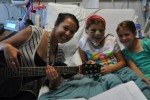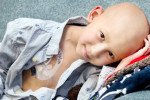Written by Heidi Wallis
After six years of marriage, my husband and I were excited to welcome our first child into the world in 2003. Samantha was born healthy and passed her newborn screening, the heel prick bloodspot taken in the hospital. She behaved like the typical baby for the first few months. She slept through the night and ate well, too.
At 18 months, Sam finally began to walk. I was told this was “just soon enough” by her pediatrician. From then on, however, we began to notice that Sam was lagging behind other kids her age. She had some early intervention through the school district, but by 3, her pediatrician referred us for developmental testing.
The testing revealed that Sam “barely” scored on the autism spectrum. That was ten years ago. I think things have changed since then, but for us, it felt like we were given a diagnosis and left to figure things out on our own. We tried to help her in every way imaginable — lots of home therapy prescribed by speech therapists, occupational therapists and a local child development group. We bought a sauna to sit in with her and “get the toxins out.” We tried gluten- and casein-free diets. We were desperate.
At 5, Sam began having absence seizures, the very brief type of seizure that looks like an eye roll but lasts about a second longer than what is normal. I finally caught one of these moments on video and took it to the pediatrician.
We were immediately referred to Dr. Michael Lloyd, a neurologist at Primary Children’s Hospital. He ordered an electroencephalogram (EEG) which confirmed seizure activity. Other neurologists might have stopped there, but he decided to order an MRI to rule out a physical cause, like a tumor. During the MRI, a second test was performed called a magnetic resonance spectroscopy (MRS). This test shows the bio-chemical activity in the brain, and this is where we got our first clue that there was a cause behind the symptoms, a lack of creatine in her brain! It turns out that creatine, the stuff you hear about body builders taking, is a pretty important source of energy for the brain as well as muscles.
Sam was then sent to Dr. Nicola Longo, an expert in inherited metabolic diseases for Primary Children’s Hospital, for a genetic investigation into why there wasn’t a normal amount of creatine in her brain. He ordered DNA testing and the results came back as a Guanidinoacetate Methyltransferase (GAMT) deficiency. Any parent that has searched years for answers can tell you that any answer is a huge relief. And, GAMT has a treatment! We were so excited. The main part of treatment, taking creatine orally, is so simple, too. It’s a relatively inexpensive over-the-counter supplement.
When Sam was diagnosed at 5, she was non-verbal. She had utterances of words that only my husband and I could recognize. Less than a year later, she was speaking in phrases that others could understand! Sam is now 13 and still far behind her peers developmentally and will need the care of others for the rest of her life. She battles recurrent seizures that are now the full-blown, convulsive type. Still, she has come so far thanks to treatment. She is a joy in my life and has made me a stronger person than I ever would have been without her.
Three years after Sam’s diagnosis, our fourth child, Louis was born. We knew of the risk of GAMT deficiency before we had him (25 percent chance), but we had also heard that GAMT was fully treatable if caught at birth. Sure enough, Louis has GAMT and began treatment just a few days after birth.
Today, Louis is 5 and is so excited for kindergarten. He hasn’t missed a beat since birth. Thanks to the thorough testing of our neurologist and metabolic geneticist at Primary Children’s, Sam’s quality of life has been greatly improved, and Louis’ life has been saved. We feel so fortunate to have such great care, and are proud that Utah is the first state to include GAMT on their newborn screening. No child born in Utah with GAMT will have to struggle for years to find an answer to “autism-like” symptoms.
Thank you, Primary Children’s.
Search Our Blog
Our Instagram
Recent Posts
- Solving the Puzzle of GAMT Deficiency March 23, 2017
- Why Child Life Specialists Make a Children’s Hospital So Unique March 10, 2017
- How to Keep Your Kids Teeth Healthy February 27, 2017
- Bringing Music Into the Hospital to Enhance Care February 2, 2017
- “Though He Be But Little, He is Fierce . . . ” A Parent Reflects on Baby Born with Terminal Disease January 6, 2017
Our Most Popular Posts
 Street Safety: 10 Pedestrian Safety Tips for Kids 14 views
Street Safety: 10 Pedestrian Safety Tips for Kids 14 views - Solving the Puzzle of GAMT Deficiency 14 views
 5 Acupressure Points Every Parent Should Know 12 views
5 Acupressure Points Every Parent Should Know 12 views - Why Child Life Specialists Make a Children’s Hospital So Unique 8 views
 Orthopedic Care by the Numbers 4 views
Orthopedic Care by the Numbers 4 views  “We Have Seen Many Miracles . . . ” the Healing Journey for a Baby With Omphalocele 4 views
“We Have Seen Many Miracles . . . ” the Healing Journey for a Baby With Omphalocele 4 views - “Excellent Care, Kind Words, & Loving Support . . . ” Teen Fights to Keep Her Beating Heart 4 views
- Sandy Pediatric Rehab Team Moves to New Clinic at Riverton Hospital 4 views
 Spa Vs. Clinical Massage: What’s the Difference? 4 views
Spa Vs. Clinical Massage: What’s the Difference? 4 views  Pediatric Liver Transplant Program Celebrates 200 Lives Saved and 20 Years 4 views
Pediatric Liver Transplant Program Celebrates 200 Lives Saved and 20 Years 4 views
Archives
- March 2017 (2)
- February 2017 (2)
- January 2017 (1)
- December 2016 (3)
- November 2016 (1)
- October 2016 (5)
- September 2016 (4)
- August 2016 (6)
- July 2016 (4)
- June 2016 (4)
- May 2016 (1)
- April 2016 (3)
- March 2016 (5)
- February 2016 (6)
- January 2016 (7)
- December 2015 (5)
- November 2015 (8)
- October 2015 (8)
- September 2015 (2)
- August 2015 (1)
- July 2015 (3)
- June 2015 (2)
- May 2015 (2)
- March 2015 (3)
- February 2015 (2)
- January 2015 (2)
- November 2014 (1)
- October 2014 (1)
- September 2014 (3)
- August 2014 (2)
- July 2014 (4)
- June 2014 (2)
- May 2014 (4)
- April 2014 (6)
- March 2014 (4)
- February 2014 (1)
- September 2013 (1)
- February 2013 (1)
- June 2012 (1)















